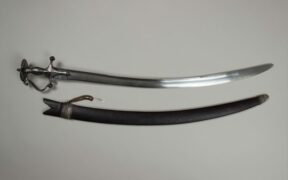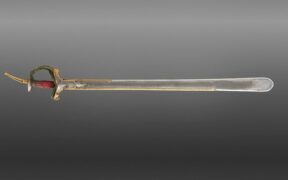Our content features commercial links to our products, committed to transparent, unbiased, and informed editorial recommendations. Learn More
Exploring The Indian Gauntlet Sword Known as the Pata
NO AI USED This Article has been written and edited by our team with no help of the AI
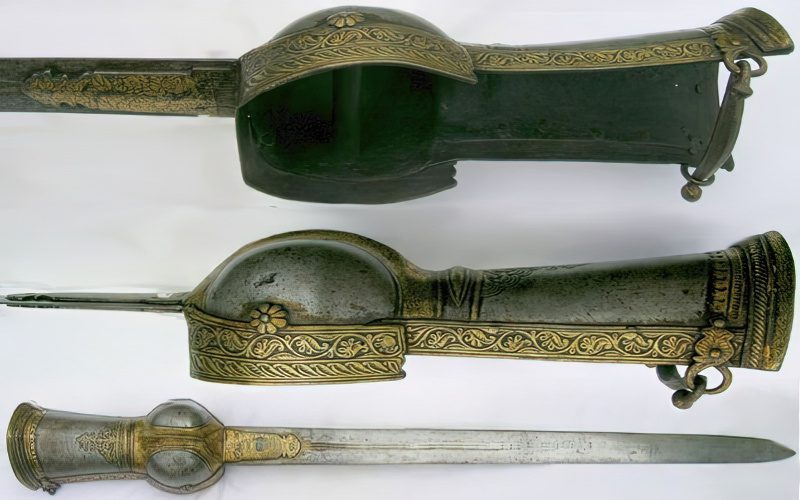
A Gauntlet Sword is a bladed weapon with a gauntlet as its handle, but in modern terms, it mostly refers to the Indian Pata. The Pata is a straight double-edged sword with a metal gauntlet built into the handle to protect the user’s hand.
In this article, we shall discuss the Indian Gauntlet Sword, known as Pata or Danda Pata. We shall start off with its unique characteristics and how it can best be put to use. Finally, we shall go over its interesting history and its European counterpart.
Characteristics of the Gauntlet Sword
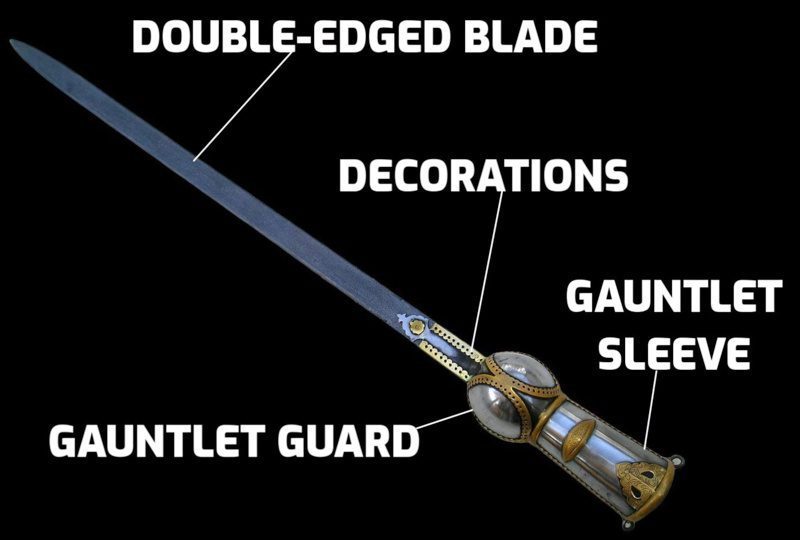
The most unique characteristic of the Gauntlet sword is its handle, hence the name. It is a metal cup with a sleeve for the user to insert his hand and hold it. It looks very unorthodox for battle, but the gauntlet offered maximum protection. The gauntlet also had decorations and inscriptions that made it very decorative.
Blade
The blade of the Gauntlet Sword, or the Indian Pata, is straight and double-edged, meaning that it is sharpened on both sides, rendering it powerful for slashing attacks. It ends with a sharp tip that can be used for thrusting as well. The beginning of the blade is known to have a ricasso or unsharpened part, which typically had decorations on it.
The blade of the Gauntlet Sword can be rigid and stiff, but sometimes, the Pata was known to have had a flexible blade that allowed for circular slashing motions. The typical blade length of the Pata Gauntlet Sword can be from 27 to 35 inches (70 to 90 cm) long, but some can be even longer.
Guard
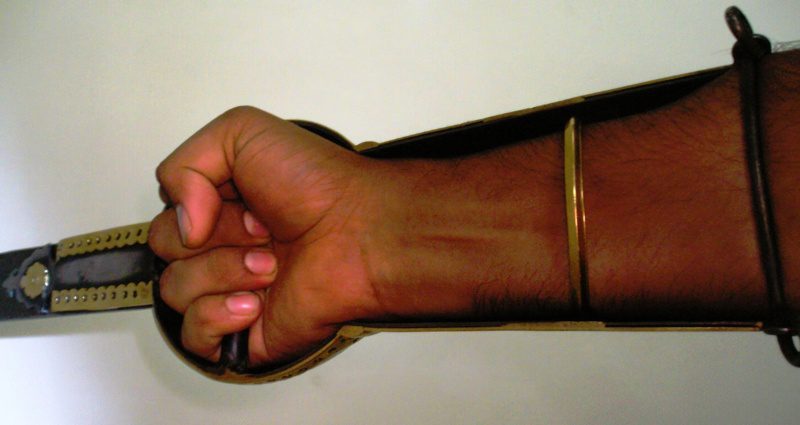
The guard is round and could either be made into a full guard that would encompass the entirety of the wielder’s hand or a half-circle that only covered the back of the user’s hand. It was made out of metal and was very protective. It was widened just enough to fit the palm perfectly, and most of the time, the outer layer had decorations on it.
These decorations typically were of animals native to India or things from legends like mythological creatures. You could commonly find a tiger’s head with an open mouth, a fish, an elephant, and even a dragon’s head. The blade was meant to look like a tongue coming out of the animal’s mouth.
Handle
The handle of the Gauntlet Sword was made to look like, well, a gauntlet. The user can place their hand inside of it like a glove. Inside the gauntlet were 2 to 3 metal belts that would strap the wielder’s arm into the gauntlet for better support and control. At the end of the gauntlet was a handle for the wielder to grip.
On the inside of the Gauntlet Sword, there was typically padding so that it could be much more comfortable to use. Just like the guard, the handle and sleeve can either fully surround the hand or just cover the outer part of the user’s hand.
This handguard could either be long enough to fit only the hand of the user, but it could sometimes extend all the way to the elbow. The typical length for the gauntlet on the Gauntlet Sword was around 8 to 12 inches (20 to 30 cm) long.
Length
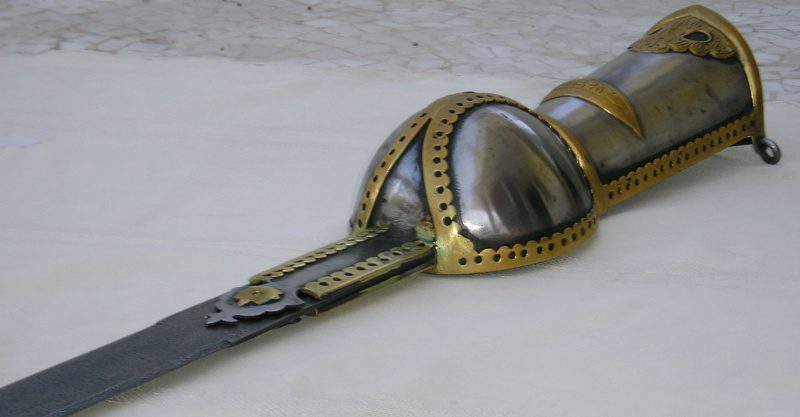
The Gauntlet Sword surprisingly doesn’t fit the short swords category as you might expect. It is a fairly long-bladed sword that was sometimes used by mounted warfare units as well, but there were also some short Gauntlet Swords too. A common overall length for the Gauntlet Pata Sword is in the range of 17 to 47 inches (45 to 120 cm).
Weight
The metal gauntlet and long blade meant that the Gauntlet Sword was fairly heavy compared to other swords. The usual weight for the Indian Gauntlet Sword was 3 lbs (1.4 kg). However, there are also some that can even reach the 4.4 lbs mark (2 kg).
Use of the Gauntlet Sword
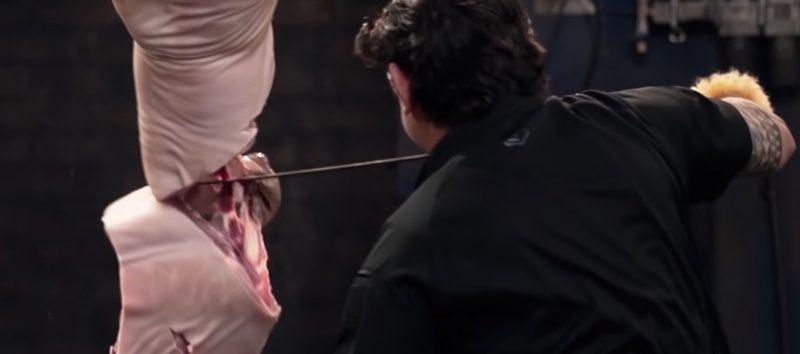
The Gauntlet Sword is literally a one-handed sword since the hand has to go inside of it to use it properly. This Indian sword has a double-edged blade which makes it powerful for slashing strikes, but it features a sharp tip that can be used for thrusting and stabbing as well. It was commonly used with a shield in the opposite hand.
While the gauntlet offers much more protection to the wielder, it weakens the flexibility and the motions that you are able to do with a normal sword. Many of the fast strikes and fighting poses are simply impossible to do, and it is a very hard sword to master.
Warfare
While the Gauntlet Sword was used in warfare, it didn’t see that much combat. There are instances where it was known to cut through the armor of the enemy, but this was probably because India, at the time, did not use plated armor.
Protection
There are cases where the blade was made to be flexible, like the Indian Whip sword, and this made it very powerful against unarmored opponents. It had a sphere of control around it and could scare off enemies easily. It’s hard to engage an opponent when they’re swinging a flexible blade around them that can easily cut off a limb or seriously injure you.
Symbol of Prowess & Decorative
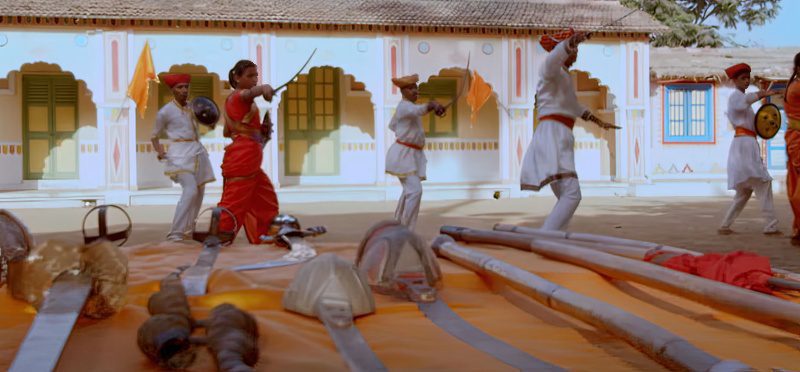
The Gauntlet Pata sword was ignored by many soldiers because it was difficult to master, thanks to its design. Only the best swordsmen could wield it, which is why nobles tended to have it to show their prowess and skill. Some of them are simply decorative pieces that have very interesting art on their gauntlet and blade.
Martial Arts & Modern
Today, the Gauntlet Pata Sword still plays a vital role in the tradition of India and is well respected in many Indian martial arts. The most popular ones are the Talim and Mardani Khel, where the Pata is described as a windmill type of weapon meant to be used in circular round slashing strikes.
History of the Gauntlet Sword
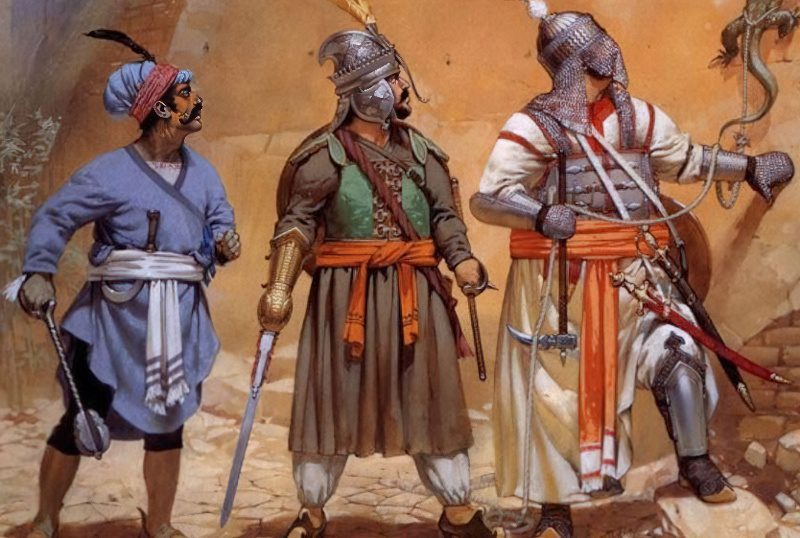
The origin of the Gauntlet Pata Sword, known as Dandpatta, is from Medieval India. The latest sources that have been found on stone inscriptions might date this sword as early as the 12th century, but it didn’t see real use until the 15th and 16th centuries. However, the most popular period for it is the 17th and 18th centuries, which is most likely due to a simplified version of the Indian Katar dagger.
The Indian Gauntlet Sword is generally linked with the Maratha warriors who used these swords during their final stand in many desperate situations. After the Maratha warriors come the Rajput and Mughal dynasties which are said to have used these swords as cavalry-slashing weapons.
The real popularity came in the battles where the tradition says that Marathi ruler Shivaji and his renowned commander Tanaji Malusare, the hero of the major Battle of Sinhagad of the 17th century, were well trained with gauntlet swords, as was Shivaji’s bodyguard Jiva Mahala, whose life he saved at the Battle of Pratapgad with a Gauntlet Sword.
It didn’t have all that much popularity in the army, but it was a very respected decorative weapon of the nobility, especially in 19th-century India.
Was the Gauntlet Sword Battle-Effective?
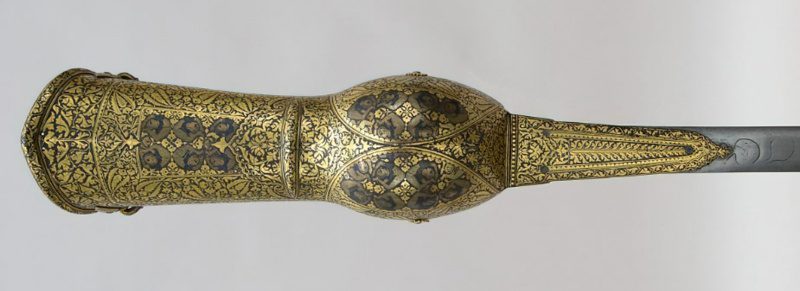
It required a significant amount of time and effort to become skilled and competent with the Pata Gauntlet Sword since it was a difficult weapon to wield. It was equally used by lords, commanders, and footsoldiers but very rarely. That is why it was simply skipped out on when it came to battle, but nobles loved putting it beside them as a symbol to show their sword-wielding skills.
There are instances where it was used by the cavalry, but it wasn’t as effective as other swords. It’s thrusting and stabbing ability, with the discomfort and lack of flexibility would make the horsemen fall from their mount if they used it.
The Marathas of India were underdogs for a large portion of their history and were severely outnumbered. That is why the Gauntlet Sword was mainly used in difficult mountainous paths, dense forests, and ravines. It gave them an extra edge in battle when it came to using their hit-and-run tactics.
Conclusion
It’s safe to say that the Gauntlet Sword is one of the most visually striking and intriguing bladed weapons ever created in India. Sword enthusiasts want and respect this unique blade, which resembles a bracer gauntlet, for both practical purposes and as an ornament.
